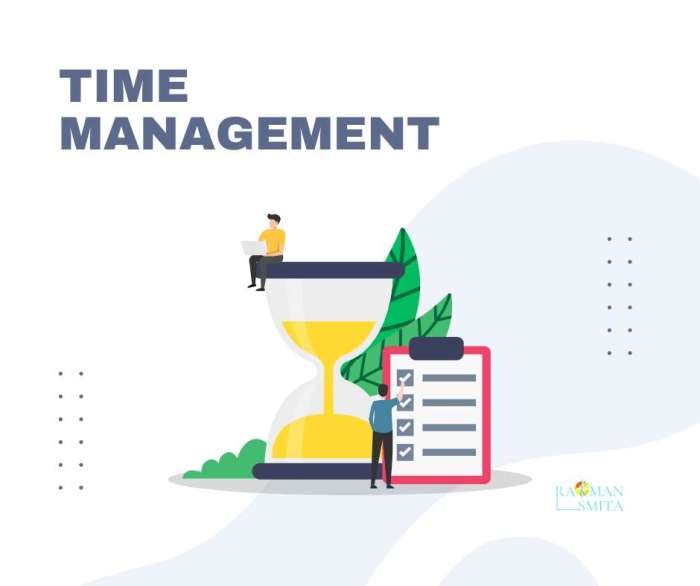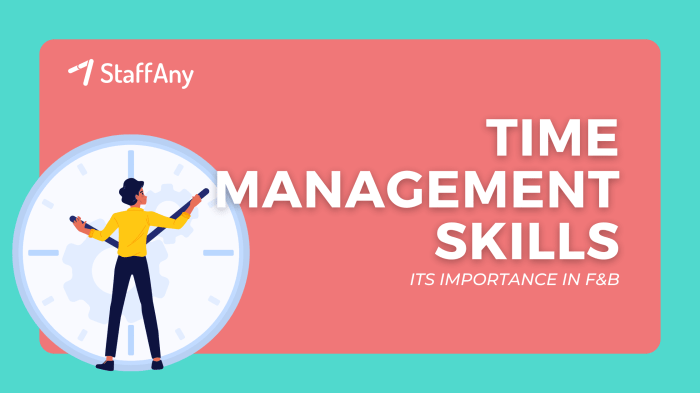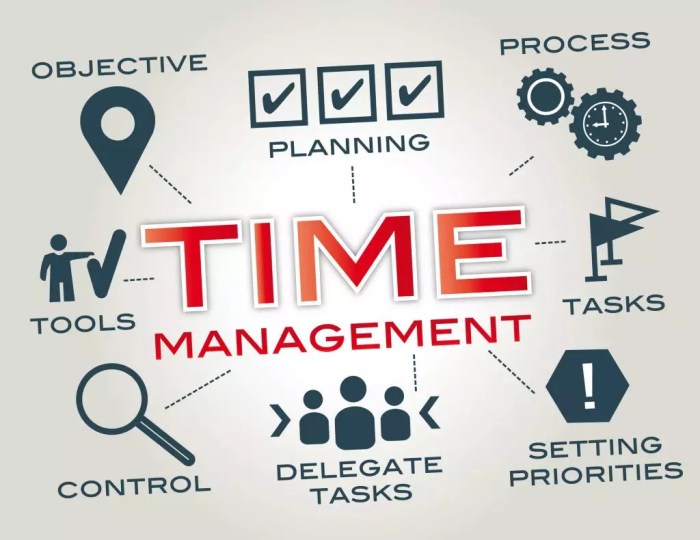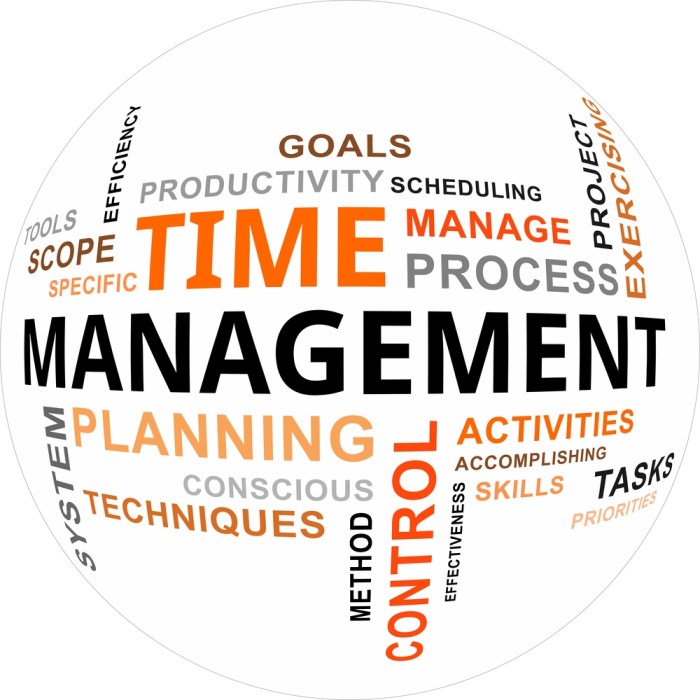Time Management Mastering Your Time
Effective time management isn’t just about squeezing more tasks into your day; it’s about strategically allocating your time to achieve your goals and enhance your well-being. This exploration delves into proven techniques, practical strategies, and essential tools to help you navigate the complexities of modern life and gain control of your schedule. We’ll examine the impact of procrastination, explore various time management methodologies, and discuss how to build a personalized system that works for you.
From understanding the core principles of effective time management to overcoming common obstacles like distractions and multitasking, this guide provides a comprehensive framework for optimizing your productivity and reducing stress. We’ll also delve into the crucial link between time management and overall well-being, highlighting the importance of incorporating breaks, maintaining a healthy work-life balance, and preventing burnout.
Defining Time Management
Time management is the process of planning and exercising conscious control over the amount of time spent on specific activities, especially to increase effectiveness, efficiency, and productivity. It’s not about cramming more into your day, but about prioritizing tasks and using your time strategically to achieve your goals. Effective time management allows for a better work-life balance and reduces stress.
Effective time management hinges on several core principles. These principles, when applied consistently, can significantly improve one’s ability to manage their time effectively.
Core Principles of Effective Time Management
Effective time management relies on understanding your priorities, planning your activities, and consistently monitoring your progress. It involves setting realistic goals, breaking down large tasks into smaller, manageable steps, and scheduling time for both work and personal activities. Prioritization is key, focusing energy on high-impact activities that move you closer to your objectives. Regular review and adjustment of your schedule is also crucial for maintaining momentum and adapting to unexpected events. Finally, effective time management involves learning to say “no” to commitments that don’t align with your priorities.
Common Time Management Pitfalls
Many common habits hinder effective time management. Poor planning, such as failing to prioritize tasks or create a realistic schedule, often leads to wasted time and missed deadlines. Perfectionism, while admirable, can become a significant obstacle, leading to excessive time spent on minor details at the expense of larger, more important tasks. A lack of delegation, refusing to entrust tasks to others, can overload an individual’s schedule and limit productivity. Finally, frequent interruptions and a lack of focus contribute to reduced efficiency and an inability to complete tasks within allocated timeframes. For example, constantly checking social media or responding to non-urgent emails can significantly disrupt workflow.
Strategies for Identifying Personal Time-Wasters
Identifying personal time-wasters requires self-awareness and a willingness to honestly assess one’s daily routines. One effective method is to keep a detailed time log for a week, noting every activity and the time spent on it. Analyzing this log reveals patterns of time consumption and highlights areas where time is being wasted. Another approach involves reflecting on feelings of frustration or overwhelm; these often signal areas where time management strategies could be improved. Finally, using productivity tracking apps can offer objective data on time usage, providing insights into where improvements can be made. For instance, an app might reveal that excessive time is spent on email, prompting a strategy for better email management.
Impact of Procrastination on Productivity
Procrastination significantly impacts productivity by delaying the completion of tasks, leading to increased stress and reduced quality of work. The longer tasks are put off, the more overwhelming they become, creating a vicious cycle of avoidance and further delay. This often results in rushed work, missed deadlines, and a sense of inadequacy. For example, delaying a major project until the last minute can lead to poor quality work, missed opportunities, and significant stress. Procrastination also reduces the overall efficiency of workflow, as time spent on other tasks is often wasted due to the looming pressure of the delayed task.
Simple Time Audit Worksheet
A simple time audit can be a powerful tool for identifying time wasters and improving time management. Below is a sample worksheet:
| Activity | Time Spent | Priority (High/Medium/Low) | Improvement Suggestions |
|---|---|---|---|
| Checking Emails | 1 hour | Medium | Schedule specific times for email checking. |
| Social Media | 30 minutes | Low | Limit social media use to designated breaks. |
| Project X | 3 hours | High | Break down project into smaller tasks. |
| Meetings | 2 hours | Medium | Prepare agendas beforehand and stick to them. |
Time Management Techniques

Effective time management isn’t about cramming more into your day; it’s about prioritizing tasks and working smarter, not harder. Several techniques can help you achieve this, each with its own strengths and weaknesses. Understanding these methods and choosing the right fit for your work style is crucial for maximizing productivity and reducing stress.
Comparison of Time Management Methods
Three popular time management methods—the Pomodoro Technique, the Eisenhower Matrix, and Time Blocking—offer distinct approaches to organizing your time. The Pomodoro Technique focuses on short bursts of focused work interspersed with breaks, promoting concentration and preventing burnout. The Eisenhower Matrix prioritizes tasks based on urgency and importance, helping you focus on high-impact activities. Time Blocking allocates specific time slots for predetermined tasks, creating a structured schedule and improving predictability. While all three aim to improve efficiency, they differ significantly in their approach and suitability for various tasks and personalities. The Pomodoro Technique is ideal for tasks requiring deep concentration, while the Eisenhower Matrix is best for managing a large workload with diverse priorities. Time Blocking is particularly effective for individuals who thrive on structure and predictability.
Benefits and Drawbacks of Time Management Methods
The Pomodoro Technique, while effective for focused work, can be disruptive if interrupted frequently. Its rigid structure might not suit all projects or personalities. The Eisenhower Matrix, while excellent for prioritization, requires regular reevaluation of tasks as priorities shift. Its simplicity, however, makes it easily adaptable. Time Blocking, though highly structured, can be inflexible and may struggle to accommodate unexpected events or urgent tasks. Its success depends on accurate time estimation and adherence to the schedule.
Implementing the Pomodoro Technique
The Pomodoro Technique is a straightforward yet powerful method. Here’s a step-by-step guide to implementing it:
- Choose a task to focus on.
- Set a timer for 25 minutes (one Pomodoro).
- Work on the task without interruption for the entire 25 minutes.
- Take a 5-minute break when the timer goes off.
- After four Pomodoros, take a longer break of 15-20 minutes.
- Repeat the cycle as needed.
Utilizing a Digital Calendar for Scheduling
A digital calendar is a powerful tool for time management. Effective utilization involves more than just entering appointments. Color-coding tasks based on priority or project, setting reminders, and utilizing recurring events features can significantly enhance its effectiveness. For example, you might assign a specific color to urgent tasks, another to personal appointments, and yet another to recurring meetings. Setting reminders ensures you don’t miss important deadlines or appointments. Using the recurring event function for regular tasks, such as weekly team meetings or daily exercise, streamlines scheduling and reduces cognitive load.
The Eisenhower Matrix
Imagine a 2×2 square. The vertical axis represents urgency (Urgent/Not Urgent), and the horizontal axis represents importance (Important/Not Important). The top-left quadrant, “Urgent and Important,” contains crises, deadlines, and pressing problems requiring immediate attention. The top-right quadrant, “Important but Not Urgent,” houses planning, relationship building, and prevention activities. The bottom-left quadrant, “Urgent but Not Important,” contains interruptions, some meetings, and pressing matters that are often distractions. The bottom-right quadrant, “Not Urgent and Not Important,” encompasses time-wasting activities like excessive social media use or busywork. Effective use involves focusing on the “Important but Not Urgent” quadrant to prevent tasks from becoming urgent, while addressing the “Urgent and Important” quadrant promptly.
Prioritization and Goal Setting

Effective time management hinges on the ability to prioritize tasks and set achievable goals. Without a clear understanding of what needs attention first and a roadmap to success, even the best time management techniques can fall short. This section will explore strategies for prioritizing tasks, setting realistic goals, and tracking progress.
Prioritizing Tasks Based on Urgency and Importance
The Eisenhower Matrix, also known as the Urgent-Important Matrix, provides a valuable framework for prioritizing tasks. This method categorizes tasks based on their urgency (how soon they need to be done) and importance (how significant they are to your overall goals). Tasks are then categorized into four quadrants: Urgent and Important (Do First), Important but Not Urgent (Schedule), Urgent but Not Important (Delegate), and Neither Urgent nor Important (Eliminate). By consistently applying this matrix, individuals can focus their energy on high-impact activities and avoid getting bogged down in less crucial tasks. For example, an urgent and important task might be meeting a critical deadline for a project, while an important but not urgent task could be planning for a future marketing campaign.
Setting Realistic and Achievable Goals
Setting goals is crucial for focused effort and motivation. However, goals must be realistic and achievable to avoid frustration and burnout. This involves considering available resources, time constraints, and personal capabilities. Overly ambitious goals can lead to discouragement, while overly simplistic goals may not provide sufficient motivation. The key is to strike a balance between challenging oneself and setting attainable targets. For example, instead of aiming to write a novel in a month, a more realistic goal might be to write a chapter a week.
Breaking Down Large Tasks into Smaller Steps
Large, complex tasks can often feel overwhelming, leading to procrastination. Breaking them down into smaller, more manageable steps makes the overall project less daunting and provides a sense of accomplishment as each step is completed. This also allows for more effective time allocation and progress monitoring. For instance, if the goal is to renovate a kitchen, the project can be divided into smaller tasks such as demolition, plumbing, electrical work, cabinetry installation, and painting. Each of these smaller tasks can then be further broken down into even smaller steps.
The SMART Goal Framework
The SMART goal framework provides a structured approach to goal setting. SMART stands for Specific, Measurable, Achievable, Relevant, and Time-bound. A SMART goal clearly defines what needs to be accomplished, how success will be measured, whether it’s attainable, how it aligns with broader objectives, and when it should be completed. For example, instead of setting a vague goal like “improve fitness,” a SMART goal would be “run a 5k race in under 30 minutes within three months by running three times a week and increasing my running distance gradually.”
Tracking Progress Towards Goals
Tracking progress is essential for maintaining motivation and making adjustments as needed. A well-designed system provides regular feedback, allowing for timely intervention if goals are not being met. Here’s a system for tracking progress:
- Establish a Baseline: Determine your current starting point against your goal.
- Set Milestones: Break down your goals into smaller milestones with deadlines.
- Use a Tracking Tool: Employ a calendar, spreadsheet, or app to monitor progress against milestones.
- Regularly Review Progress: Schedule regular reviews (weekly or monthly) to assess progress and make necessary adjustments.
- Celebrate Successes: Acknowledge and celebrate achievements along the way to maintain motivation.
Tools and Technologies

Effective time management often relies on leveraging the right tools and technologies. Choosing the appropriate methods, whether digital or analog, significantly impacts productivity and overall success in achieving personal and professional goals. This section explores various tools, their advantages and disadvantages, and strategies for seamless integration into existing workflows.
Helpful Time Management Apps and Software
Many applications are designed to assist with time management, each offering a unique set of features. Selecting the right app depends on individual needs and preferences. Consider factors such as ease of use, platform compatibility, and the specific features offered.
- Todoist: This task management app allows users to create and organize tasks, set deadlines, and collaborate with others. Its intuitive interface and robust features make it a popular choice for individuals and teams. Benefits include clear task visualization, flexible project organization, and cross-platform accessibility.
- Asana: Asana is a project management tool that facilitates teamwork and task delegation. It offers features such as Gantt charts for visualizing project timelines, customizable workflows, and progress tracking. Its strength lies in its collaborative features, making it suitable for managing complex projects.
- Google Calendar: A widely used calendar application, Google Calendar provides scheduling capabilities, reminders, and integration with other Google services. Its ease of use and broad compatibility make it a versatile option for managing appointments and deadlines.
- Forest: This unique app gamifies the process of staying focused. Users “plant” a virtual tree at the start of a work session; if they leave the app, the tree dies. This encourages uninterrupted work periods and promotes mindful focus.
Digital vs. Analog Methods: Advantages and Disadvantages
The choice between digital and analog time management methods hinges on personal preferences and working styles. Both approaches have distinct advantages and disadvantages.
| Method | Advantages | Disadvantages |
|---|---|---|
| Digital | Increased accessibility, data storage, automated reminders, integration with other tools | Potential for distractions, reliance on technology, learning curve for some apps |
| Analog | Reduced distractions, tactile engagement, improved focus for some individuals, no reliance on technology | Limited data storage, less flexibility for scheduling changes, requires manual updates |
Effective Utilization of Productivity Tools
While technology offers significant benefits, over-reliance can hinder productivity. It is crucial to utilize tools strategically, avoiding excessive dependence and ensuring they complement, not replace, effective time management principles.
- Mindful Tool Selection: Choose tools that align with your workflow and avoid accumulating unnecessary apps.
- Regular Review and Adjustment: Periodically evaluate the effectiveness of your chosen tools and adapt as needed.
- Technology Breaks: Incorporate regular breaks from digital devices to maintain focus and prevent burnout.
- Prioritize Core Tasks: Don’t let technology become a barrier to completing essential tasks.
Creating a Personalized Time Management System
A personalized system integrates readily available tools to address individual needs and preferences. This involves combining different methods to create a cohesive and effective approach.
- Identify Your Needs: Determine your biggest time management challenges and select tools that directly address them.
- Combine Methods: Integrate digital and analog methods for a balanced approach. For example, use a digital calendar for scheduling and a paper planner for brainstorming.
- Experiment and Adapt: Don’t be afraid to experiment with different tools and techniques until you find a system that works best for you.
- Consistency is Key: The success of any time management system depends on consistent application.
Integrating Time Management Tools with Existing Workflows
Successful integration requires a thoughtful approach, ensuring that new tools seamlessly complement existing processes without disrupting established workflows.
- Gradual Implementation: Introduce new tools incrementally to avoid overwhelming yourself.
- Training and Familiarization: Take the time to learn how to use new tools effectively.
- Team Collaboration (if applicable): Ensure that team members are trained on new tools and processes.
- Regular Evaluation and Adjustment: Monitor the impact of new tools on workflows and adjust as necessary.
Overcoming Challenges

Effective time management isn’t simply about employing techniques; it’s about navigating the inevitable obstacles that hinder our best intentions. Procrastination, interruptions, and perfectionism are common culprits that can derail even the most meticulously planned schedules. Understanding these challenges and developing strategies to overcome them is crucial for consistent productivity and reduced stress.
Managing Distractions and Interruptions
Distractions and interruptions are pervasive in today’s hyper-connected world. Emails, social media notifications, and unexpected requests can easily disrupt concentration and derail workflow. Effective strategies involve creating a dedicated workspace free from clutter and distractions. Utilizing tools like website blockers or focus apps can help minimize digital distractions. Communicating clear boundaries with colleagues and family regarding your work time is also essential. Scheduling specific times for checking emails and responding to messages, rather than constantly monitoring inboxes, allows for focused work periods. The Pomodoro Technique, for instance, involves working in focused bursts with short breaks, enabling better concentration and minimizing the impact of brief interruptions.
Overcoming Procrastination and Improving Self-Discipline
Procrastination is a common enemy of productivity. It often stems from fear of failure, perfectionism, or simply a lack of motivation. To combat procrastination, break down large tasks into smaller, more manageable steps. This makes the overall project less daunting and provides a sense of accomplishment as each step is completed. Setting realistic deadlines and rewarding oneself for achieving milestones can also boost motivation. Practicing self-compassion is crucial; acknowledging that setbacks happen and reframing procrastination as a manageable challenge rather than a personal failing is vital for progress. Techniques like the Eisenhower Matrix (prioritizing tasks based on urgency and importance) can help focus energy on what truly matters.
Delegating Tasks Effectively
Delegation is a powerful time management tool often underutilized. Effectively delegating tasks frees up time for higher-priority activities and develops the skills of team members. Successful delegation requires clear communication of expectations, providing necessary resources and support, and trusting others to complete their assigned tasks. This involves identifying tasks suitable for delegation, selecting appropriate individuals, providing clear instructions and deadlines, and establishing a system for monitoring progress and providing feedback. For example, a manager might delegate data entry to a junior staff member, freeing up their time for strategic planning.
Coping Mechanisms for Stress Related to Time Constraints
Time pressure can significantly impact stress levels. Implementing effective coping mechanisms is essential for maintaining well-being.
- Prioritize self-care: Make time for activities that promote relaxation and rejuvenation, such as exercise, meditation, or spending time in nature.
- Practice mindfulness: Focus on the present moment to reduce anxiety about the future or regrets about the past.
- Maintain a healthy lifestyle: Adequate sleep, a balanced diet, and regular exercise contribute to better stress management.
- Seek support: Talk to friends, family, or a therapist about your challenges and feelings.
- Learn to say no: Avoid overcommitting yourself to avoid overwhelming your schedule.
- Time blocking for breaks: Schedule specific times for breaks throughout the day to avoid burnout.
Time Management and Wellbeing

Effective time management isn’t just about ticking off tasks; it’s fundamentally linked to our overall wellbeing. A well-structured schedule can significantly reduce stress, improve mental clarity, and foster a healthier lifestyle. Conversely, poor time management often leads to feelings of overwhelm, anxiety, and ultimately, burnout.
The Relationship Between Time Management and Stress Levels
Stress is often a direct consequence of feeling overwhelmed and lacking control. When we’re constantly rushing, juggling multiple deadlines, and struggling to keep up, our stress levels naturally rise. Effective time management provides a sense of control and accomplishment, mitigating this stress. By prioritizing tasks, setting realistic goals, and scheduling breaks, individuals can significantly reduce feelings of pressure and anxiety associated with a packed schedule. This proactive approach allows for more focused work during allocated times and prevents the last-minute scrambling that contributes to heightened stress.
The Importance of Breaks and Downtime
Incorporating breaks and downtime into daily schedules is crucial for maintaining productivity and preventing burnout. Regular breaks allow the mind to rest and refocus, improving concentration and creativity. These breaks don’t have to be lengthy; even short, five-minute intervals can make a significant difference. Downtime, on the other hand, involves longer periods of disengagement from work, allowing for relaxation and rejuvenation. Activities such as spending time in nature, engaging in hobbies, or simply relaxing can significantly improve mental and physical wellbeing, leading to increased energy and focus when returning to work. For example, a 15-minute walk during a workday can drastically improve afternoon productivity.
Maintaining a Healthy Work-Life Balance
A healthy work-life balance is essential for long-term wellbeing. It involves consciously allocating time for both professional and personal pursuits, ensuring neither aspect dominates the other. Setting boundaries between work and personal life is key; this might involve establishing specific work hours, turning off work notifications outside of those hours, and actively engaging in non-work related activities. Prioritizing personal commitments, such as spending time with family and friends, pursuing hobbies, and engaging in self-care activities, is equally important in maintaining a balanced lifestyle. A well-defined schedule that incorporates both work and personal time can significantly contribute to a reduced feeling of being overwhelmed.
The Impact of Sleep and Exercise on Productivity
Sufficient sleep and regular exercise are crucial for optimal cognitive function and productivity. Sleep deprivation impairs concentration, memory, and decision-making abilities, negatively impacting work performance. Aiming for 7-9 hours of quality sleep per night is essential for maintaining alertness and focus throughout the day. Regular exercise, even in short bursts, improves mood, reduces stress, and boosts energy levels. The release of endorphins during exercise acts as a natural mood enhancer, leading to increased focus and productivity. For example, a 30-minute morning workout can significantly improve cognitive function and energy levels for the rest of the day.
Strategies for Preventing Burnout
Burnout is a state of emotional, physical, and mental exhaustion caused by prolonged or excessive stress. Preventing burnout requires a proactive approach that incorporates several strategies. These include setting realistic goals, prioritizing tasks effectively, taking regular breaks, and maintaining a healthy work-life balance. Learning to say “no” to additional commitments when feeling overwhelmed is crucial. Regular self-reflection, identifying personal stressors, and actively implementing coping mechanisms are also essential for preventing burnout. Seeking support from colleagues, friends, or family can provide valuable emotional support and perspective. Regular vacations and time off are also important for preventing burnout and allowing for complete mental and physical rest.
End of Discussion

Ultimately, mastering time management is a journey of self-discovery and continuous improvement. By understanding your personal time-wasters, implementing effective techniques, and utilizing the right tools, you can create a more balanced and fulfilling life. Remember, it’s not about doing more, but about doing what matters most, efficiently and effectively. Embrace the process, adapt strategies to suit your needs, and enjoy the rewards of a well-managed schedule.
Q&A
What if I find a technique doesn’t work for me?
Time management is personal. Experiment with different techniques until you find what best suits your style and preferences. Don’t be afraid to adapt or combine methods.
How do I deal with unexpected interruptions?
Build buffer time into your schedule. Learn to politely decline non-essential requests or delegate tasks when possible. Practice mindfulness to regain focus after interruptions.
Is it okay to take breaks?
Absolutely! Regular breaks are crucial for maintaining focus and preventing burnout. Short, frequent breaks are often more effective than one long break.
How can I stay motivated to stick to a time management system?
Start small, celebrate milestones, and regularly review your progress. Find an accountability partner or use a reward system to reinforce positive habits.



